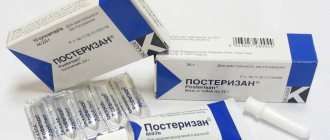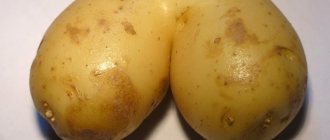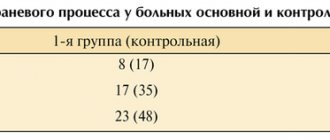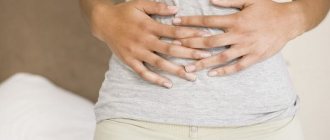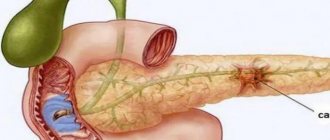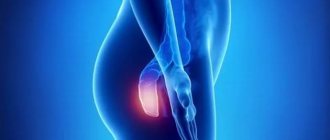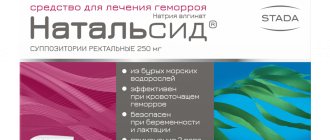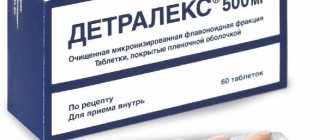Currently, few people have not encountered or heard of such a disease as hemorrhoids. The disease itself is not fatal, but it entails very unpleasant and painful sensations, and the most unpleasant thing is that every year more and more people are faced with this problem.
In the fight against hemorrhoids, the prevention and elimination of inflammatory processes caused by this disease plays a very important role. Posterizan suppositories are currently the most effective remedy for eliminating the effects of hemorrhoidal inflammation.
Release form, composition and packaging
Ointment for rectal and external use
white with a yellowish tint, with a characteristic smell of phenol.
| 1 g | |
| inactivated microbial cells E. coli | 330 million |
Excipients:
lanolin, petroleum jelly, phenol (preservative).
25 g - aluminum (1) complete with applicator - cardboard packs.
Rectal suppositories
white or white with a yellowish tint, with a characteristic smell of phenol.
| 1 sup. | |
| inactivated microbial cells E. coli | 660 million |
Excipients:
solid fat, macrogolglycerol hydroxystearate, phenol (preservative).
5 - blisters (2) - cardboard packs.
Clinical and pharmacological group:
Drug for topical use for diseases of the anorectal area
Registration No.:
- ointment for rect. and external note: 25 g complete with applicator - P No. 012331/01 dated 07.11.2011. Active.
- suppositories rect.: 10 - P No. 012331/02 dated November 10, 2011. Active.
Material and methods
The study was conducted from December 2015 to August 2016. It was a single-center, double-blind, randomized, parallel-group study. Each patient was assigned a randomization number.
Inclusion criteria:
1) age from 18 to 60 years;
2) the presence of chronic anal fissure;
3) being in a hospital;
4) written consent to participate in a clinical trial.
Exclusion criteria were:
1) patient’s refusal to study;
2) the occurrence of a life-threatening condition (acute profuse bleeding, myocardial infarction, acute cerebrovascular accident, Quincke's edema, anaphylactic shock, as well as any condition that required transfer of the patient to the intensive care unit);
3) Crohn's disease, ulcerative colitis, malignant tumors of any location;
4) inability to independently fill out a visual analogue scale (VAS);
5) participation in another study at the same time or within the previous 3 months;
6) the patient has already been selected for this study.
For inclusion in the study, 146 patients were prescreened, of which 110 patients were selected in accordance with the protocol. These patients met the inclusion criteria; there were no exclusion criteria at the time of screening and randomization.
All study procedures were completed in 102 (92.7%) patients out of 110. After the study was conducted and it became known which drug (posterisan or placebo) corresponded to a particular randomization number, the patients were divided into two groups. Group 1 (control) included 48 patients who received placebo for topical application. The main group - 2nd consisted of 54 patients who were treated with the drug posterizan.
8 (7.2%) patients dropped out of the study due to failure to appear on the 15th day for personal reasons or the patient's unwillingness to participate in further follow-up.
During the study, no serious adverse events were identified in any patient.
Methods for assessing each patient in the main and control groups included:
1) profilometry (at the preoperative stage);
2) general and biochemical blood test, hemocoagulogram (at the preoperative stage);
3) blood test for carriage of infections: RW, HIV, hepatitis B and C (at the preoperative stage);
4) hospitalization;
5) randomization with distribution of the drug (posterizan or placebo) to the attending physician;
6) surgical treatment (under spinal anesthesia) - excision of the anal fissure with/without pneumodivulsion of the anal sphincter;
7) prescription of painkillers;
cytological examination of a smear-imprint from the area of the postoperative wound before dressing on days 2, 15 and 28 after surgery;
9) digital examination of the anal canal and wound defect daily during dressing;
10) identification of possible postoperative complications, which were recorded in special documentation;
11) daily dressings with one of two drugs (posterizan or placebo);
12) daily filling out by the patient of a 10-point VAS pain questionnaire;
13) visual assessment of wound healing by a doctor on days 2, 15 and 28 after surgery;
14) daily assessment of the restoration of self-care ability according to the Barthel scale;
15) assessment of quality of life on the QoL SF-36 scale before surgery, on the 28th day after surgery;
16) control visit on the 28th day and the end of the study.
The study involved patients with chronic anterior or posterior anal fissure. Treatment took place in a hospital. Each patient underwent surgical treatment. The duration of the operation ranged from 18 to 40 minutes (average - 23.8±7.7 minutes).
Surgical treatment of anal fissure using controlled pneumodivulsion of the anal sphincter is a modern technique. This low-traumatic method of eliminating spasm of the internal sphincter is performed using a pneumatic balloon. This type of surgical intervention allows you to effectively eliminate spasm of the internal sphincter. Excision of the fissure with pneumodivulsion of the anal sphincter significantly reduces the number of relapses of the disease and at the same time minimizes the risk of developing anal sphincter insufficiency and disability of patients [1].
A comparative analysis of the two groups of patients did not reveal significant differences in gender and age composition. Thus, in the main and control groups there were 36 (67%) and 24 (50%) women, respectively. Men in the main group made up 18 (33%) patients, in the control group - 24 (50%) ( p
>0,05).
The age of the patients in the main group ranged from 22 to 69 years, but most of them were people of working age (average age - 45.8±13.2 years). In patients in the control group (from 24 to 72 years), the average age was 43.2±12.2 years ( p
>0,05).
There were also no significant differences in the nature of surgical interventions. In most cases, patients in the main and control groups underwent surgical treatment involving pneumodivulsion of the anal sphincter with excision of anal fissures: in 47 (87%) and 40 (83.3%), respectively, since, according to profilometry data, these patients were diagnosed spasm of the internal sphincter. Excision of fissures without pneumodivulsion was performed in 7 (13%) patients of the main and 8 (16.7%) control groups ( p
>0.05) (Fig. 1).
Rice.
1. The presence of spasm of the internal sphincter in patients of both groups. Both groups of patients were also comparable in terms of laboratory parameters in the preoperative period. In the majority of patients in both the main and control groups, blood hemoglobin (Hb) was within normal values - in 43 (79.6%) and 36 (75%), respectively. Mild anemia was detected in 11 (20.4%) patients of the main group and 12 (25%) of the control group ( p
>0.05) (Table 1).
Table 1. Laboratory tests in patients of the main and control groups (hemoglobin indicators)
Normal ESR values in the main group were detected in 43 (79.6%) patients, and in the control group - in 42 (87.5%) ( p
>0.05) (Table 2).
Table 2. Laboratory tests in patients of the main and control groups (ESR indicators)
The treatment regimens used required patients to stay in the hospital for an average of about 1 week. Almost all patients included in the main and control groups were operated on the next day after hospitalization, since all the necessary examinations were carried out at the outpatient stage, before hospitalization. The total and postoperative bed days in patients of the main and control groups did not differ statically from each other (Fig. 2).
Fig.2. General and postoperative bed days in patients of the main and control groups.
Thus, each group included patients homogeneous in terms of main indicators.
pharmachologic effect
A drug for topical use for diseases of the anorectal area.
The cell wall antigens and E. coli metabolites contained in Posterisan, upon contact with the mucous membrane of the rectum and the skin of the anogenital area, increase the local resistance of tissues to the effects of pathogenic microflora.
The drug stimulates the T-system of immunity, at the site of exposure increases the phagocytic activity of leukocytes and cells of the reticuloendothelial system, nonspecific immune factors, reduces vascular exudation during inflammation, normalizes the permeability and tone of blood vessels, stimulates the regeneration of damaged tissues.
Contraindications and side effects
Posterizan suppositories are not used in pediatrics for children under 14 years of age. It should also not be used in patients who have noted intolerance to the substances included in the suppository.
Side effects
As such, no side effects were observed during the use of Posterizan suppositories. In rare cases, local redness of the tissues may occur due to the action of the phenol contained in the suppository. As well as allergic manifestations: redness, eczematous rashes, local itching, urticaria in people with intolerance to one of the components of the drug. To avoid such consequences, be sure to consult your doctor.
If suppositories are accidentally taken orally, gastrointestinal disorders may occur, so you must always adhere to the recommendations for use and observe safety measures. And also keep the drug out of the reach of children.
Use in pregnant women
Pregnancy and breastfeeding are not contraindications to the use of Posterizan suppositories. Treatment can be carried out, but under the supervision of a doctor.
Dosage regimen
The ointment should be applied in a thin layer to the affected area of the skin and mucous membrane in the morning and evening, as well as after each act of bowel movement. To insert the ointment deeper into the anus, you can use the screw-on applicator included with the kit.
Suppositories are used 1 in the morning and in the evening, as well as after each act of defecation.
The combined use of ointments and suppositories is possible.
The duration of treatment is 2-3 weeks.
Indications for use
Candles (suppositories) Posterizan are used both as an independent drug and in the complex treatment of patients with hemorrhoids. It must be remembered that in patients with an associated fungal infection, local antifungal drugs should be used in parallel with Posterisan. Posterizan is also used for fissures, as well as eczema of the anal and rectal areas.
Candles Posterizan
